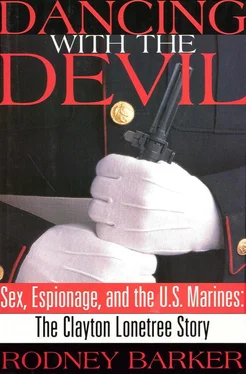When it was the defense’s turn to cross-examine the witnesses, the focus in the courtroom seesawed between two very different interpretations of Sergeant Lonetree’s intentions and state of mind when he was meeting with Uncle Sasha. Mike Stuhff and William Kunstler tried to impeach the notion that what Lonetree said to the NIS agents was a pure confession of espionage, and maintained the position that in order to understand what Lonetree was admitting to, the jury should understand his actions in the light of his decision to play the role of a double agent. In support of their contention, they pointed to portions of the confession that could be read in such a way that it did appear Lonetree purposely misled Uncle Sasha and thought the KGB already had what he was giving them. They argued that NIS agents had guided the interrogation in a direction that supported their preconceptions and prepared a statement that omitted the mitigating statements Lonetree had made over the course of the time he was in their custody. Proof, they said, lay in comparing a 260-page transcript of the taped interrogation sessions that led to the confession, and the mere 15-page confession that the NIS agents had presented him to sign.
Major Beck knew that if his case had a weakness, it lay in the circumstances surrounding the taking of the statement, but his own reading of the unedited confession had brought him to a different conclusion about the way the NIS agents had condensed Lonetree’s admission. After the defense was successful in putting before the jury the notion that it had been a document manufactured by the NIS, Major Beck put the NIS polygrapher Tom Brannon on the stand and asked him if he remembered Sergeant Lonetree’s stating, “I thought of the ugliest Americans I could think of when I handed over the photographs [of American intelligence agents to Uncle Sasha].” Brannon said he did. Asked if that quote had been put into Lonetree’s statement, Brannon said it had not.
It was apparent to Major Beck from Mike Stuhff’s opening statement that at some point defense counsel was going to bring up the patriotism of the Navajo Code Talkers and invoke the example set by Lonetree’s uncle Mitchell Red Cloud as a way of characterizing Sergeant Lonetree as a Marine who wanted to serve his country in a big way but whose plan backfired. This, in his mind, entitled him to bring on his next witness, June Dahl, Lonetree’s American History teacher when he was a junior in high school.
Instinct had told Major Beck that by this time in the trial the members were probably beginning to wonder where Lonetree’s behavior originated. It was something Beck himself had struggled with. When he did his own psychological analysis, extrapolating from Lonetree’s admission to the NIS agents that he had been motivated in part by the American government’s historical mistreatment of Indians, Beck had been willing to accept that maybe this was Lonetree’s way of bringing the Native American cause to the forefront. But that was before he’d heard from June Dahl.
Mrs. Dahl, an elderly woman who had lost none of her sharpness, had read about her former student in the St. Paul papers and she had contacted the military authorities. When she was on the stand, Major Beck allowed her to tell the court the story she had told him.
In 1979 she had taught a course called “The 1920s and 1930s,” and Clayton had been a class member. Periodically students were expected to turn in their notebooks, and when Clayton turned in his, she noticed a swastika drawn on the cover. Mentally she had raised her eyebrows, because they were not covering German history, but she didn’t say anything; she simply returned the notebook. Until the next time the notebooks were turned in and she found the swastika had been embellished with other material she could not ignore. Incendiary slogans such as “The Holocaust is a lie,” and “Jews are our misfortune,” and “Hitler had the right idea” were scrawled like graffiti across the cover.
Mrs. Dahl said she had asked Clayton to stay after class, and when she tried to talk to him about the meaning of this, he had accused her of “believing all those Jew lies.” The next time the notebook was turned in, it contained the names, addresses, and telephone numbers of members of the American Nazi Party. Never before or since, she said, had she seen such hatred in any of her students.
After initially protesting that what this witness had to say had nothing to do with the charges and was inflammatory, the defense tried to downplay Mrs. Dahl’s concerns. This was the stuff of a teenage boy’s fantasies. Clayton Lonetree did not have any idea what Nazism was about. How could he? It was a violent antiminority cult, and he was an Indian. Besides, Germany and the Soviet Union were enemies in World War II.
Major Beck thought it went deeper than that. The point that he tried to make had first been articulated for him during a conversation with the famous Soviet defector Yuri Nosenko. “You must realize, yes, the two countries fought against each other. But the end result of Nazism and Communism is the same. The socialist state takes away all ownership of property. The fascists let you keep your property but take away all the rights that go with it. The end of both is complete control and power, and they accomplish it through repression and murder.”
A light had switched on for Major Beck when he heard that. He felt that with full awareness both were repressive regimes, Lonetree had expressed a preference for the Soviet system as recently as 1986, and as far back as high school he had been infatuated with a fascist system that was equally repressive. What was the connection? Beck didn’t know for sure, but by the time Mrs. Dahl left the witness stand, a nexus had been suggested: It was because they were both the mortal enemies of the United States.
When he shuffled the order of witnesses for the prosecution, Major Beck had decided that this was the right time for the jury to hear from an expert witness who was qualified to give testimony on Soviet intelligence recruiting practices. He had wanted someone without any CIA or State Department baggage, an American citizen who could express in layman’s terms the modus operandi of Soviet intelligence agents. While reading the record of the espionage trial of John Walker, he had discovered that John Barron, a former naval intelligence officer and the author of several books about the KGB, had testified for the Justice Department. When he asked John Dion and John Martin about Barron, they spoke highly of him, calling him a great American, an excellent speaker, someone dedicated to the security of the United States. But they also said they were concerned about wearing out their welcome with Barron and did not wish to impose on him for a case that wasn’t theirs. Beck, as persuasive as he was persistent, had characterized a meeting with Barron as essential to his education, so one had been arranged at the Justice Department.
Beck and Barron had conversed for about an hour when Martin and Dion were called from the room, and even though the major had been told that Barron was not the only expert witness on espionage matters, that others could be made available, Beck had heard enough to think that Barron would be the best.
“I sure appreciate your taking the time to talk with me today, Mr. Barron,” he said with sincerity, “because your friends at Justice told me how busy you are and that I shouldn’t bother you. But I knew how knowledgeable you were when it came to the KGB, and that you, of all people, know we aren’t talking about an innocent love affair between a Soviet gal and an American Marine here.”
When John Barron nodded, Beck continued. “It’s such a shame that you aren’t going to be available to testify, however, because we are talking about the first espionage trial in the history of the Marine Corps, and it would have been nice to have you part of that.” Now he chuckled reflectively. “And I would have loved to have seen you match wits on the stand with William Kunstler….”
Читать дальше












